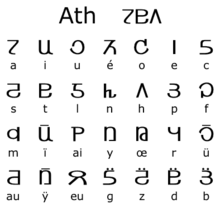- Baronh
-
Baronh is a fictional language created by Japanese science fiction author Morioka Hiroyuki and used in Crest of the Stars and Banner of the Stars. The name Baronh means "language of the Abh".
Contents
Origin
The Baronh language is derived from the ancient Japanese language, spoken until the beginning of the ninth century and recorded in Kojiki, Man'yōshū and other ancient documents. It is not precisely the ancient language itself, but a reconstructed one which is named Takamagahara language after the mythological heaven in Kojiki. In Crest of the Stars, Japanese revolutionists seeking to remove foreign influence from the Japanese language created their own "purified" version, which removed borrowed words and expressions and revived ancient ones. It was these revolutionists who established the colony that created the Abh, giving them their language.
After the Abh were freed from slavery, their language quickly, in a few generations, changed into the form seen in Morioka's works of fiction. Having not been allowed to write as slaves, the Abh previously had no writing system, and that is the biggest reason why this change proceeded so swiftly. In order to write Baronh, an alphabet called Ath, which means "letter", was created, based to some extent on the Japanese kana.
Grammar
Baronh is an inflectional or synthetic language: affixes are attached to a fixed stem to express verbal aspect and mode, and case in nouns and pronouns, Nouns and pronouns have seven cases which affixes were derived from particles in the Japanese language. Some Japanese particles remain as such.
The seven cases of Baronh are:
- nominative (used for the subject of a verb or naming a noun),
- accusative (used for the direct object of a verb),
- genitive (used to indicate relation or possession, often represented by the English "of"),
- dative (used of the indirect object of the verb, often represented by the English "to" or "for"),
- directive (originally used to show the direction of movement, similar to terminative or lative, but used to show a location without movement in modern Baronh)
- ablative (separation, source, cause, start point of movement)
- instrumental (instrumental, and a predicate of a copula).
There are four types of declension of Baronh nouns. In the first declension there is usually only one vowel and its place shifts according to its cases. For example, Abh is Abh in its nominative but changes as Bar in its genitive.
Adjectives have no change. Most of adjective consist of a stem and the ending -a, like bhoca ("large") or laca ("high"). A verb can be used as a sort of adjective in a form of its stem and -a affixes like the gerund in English. Usually adjectives follow nouns like lartnéc casna (literally "princess first"). Adverbs have no change and many adverbs were derived from adjectives, like bhoci ("largely") or laci ("highly").
Spelling
Baronh is written both in Ath (their own letters) and in some other alphabets, like the Latin alphabet.
Each letter of Ath has its own sound, though some combinations like bh stand for other sounds. Such combinations appear between consonants letters.
Every vowel is clearly pronounced except occasionally "e". When "e" appears as a part of affixes, it frequently becomes silent (for example, byrec [byːr] 'fleet', cluge [kluːɡ] 'relax').
Some consonants become silent at the end of word or in a series of consonant letters. Digraphs in <h> are used for fricatives. For example bh stands for [v], mh for [ɸ].
Greetings
- Cluge sa?: "Hello" (literally "Are you relaxing?")
- Fe cluge: "Hello" as a reply (literally "I am relaxing.")
- Carsisto!: "Hello" (in office: literally "Let's work")
- Bile éna!: "Bye" (literally "Good voyage")
- Froranto: "Farewell" (literally "I will never forget [you]")
References
Categories:- Fictional languages
- Crest of the Stars
Wikimedia Foundation. 2010.

